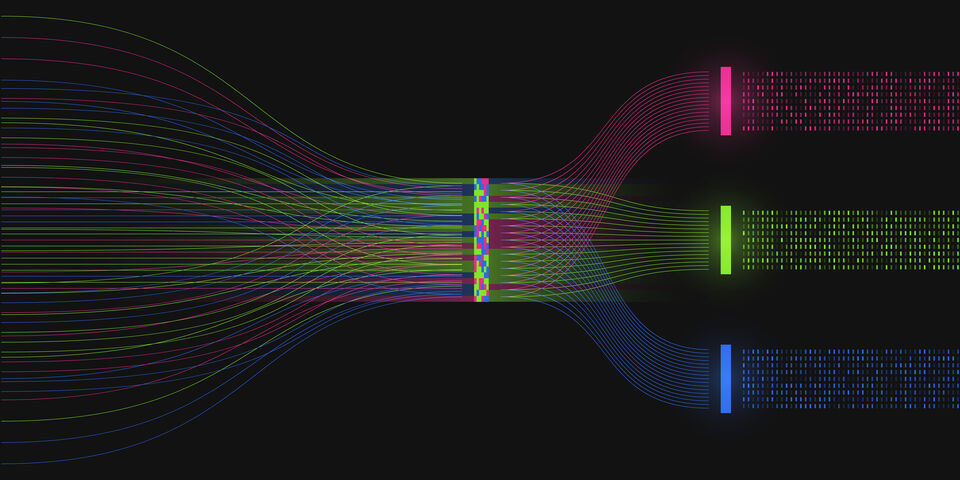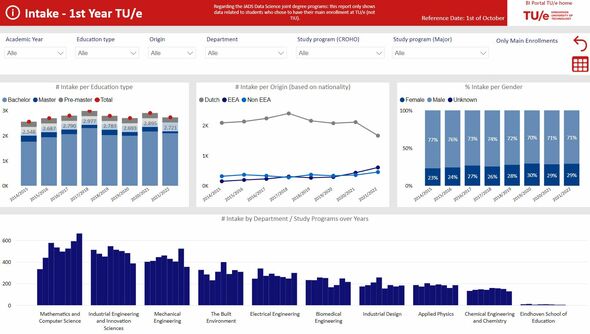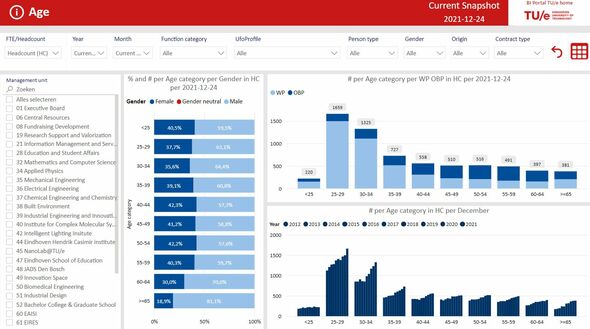BI portal now open to all TU/e employees
Four years it has been live: the Business Intelligence portal (BI portal) where you can find all kinds of information about TU/e's education, research, HRM and finance. Nevertheless, it is still not common knowledge within the organization and that needs to change. One way to achieve this is to give everyone within TU/e direct access to the portal.
So what kind of data does the BI portal offer? The number of students (over the years), the age distribution of employees, the student-staff ratio and the predicted number of students in the coming academic year are just a few examples. If you are curious about the trend in student growth over the past years, or the number of women professors working here, you can now look up these facts.
BI team lead Jeroen Bovend’eerdt: “Our aim with the BI portal is to make reliable information available to our target group of all TU/e employees (salaried, ed.) in the most accessible manner possible.” Another step towards reaching this aim has been taken with the opening of the BI portal to all TU/e employees. For open reports, as they are called, all it takes is one click on the link; requesting permission is a thing of the past. Closed reports containing more sensitive information remain available only to people with authorization. “The sensitive information isn't the only reason. It's important readers know exactly how the figures in these reports should be interpreted,” adds information analyst education Diana Braspenning.
Business and IT
Bovend’eerdt tells something of the history of the BI portal. “We've been up and running for four years now. We were initially part of the BI cluster providing education reports, now we also generate HR reports and Finance reports. These domain-specific reports now sit alongside cross-domain reports, combining data from multiple domains (such as the student-staff ratio). These are created with a team of developers, information analysts, a team leader/scrum master and a BI analytics advisor.
“The information analysts working for the BI cluster have one foot in the business (ESA for example) and one foot in the BI cluster,” explains Braspenning. “This straddling of two cultures is deliberate; business needs to inform the design of the report so that solutions are generated that are not only IT savvy but also useful to the business. Both familiarity with the business and an IT skill set are needed to build a good system.”
Quality assurance
The motivation for setting up the BI cluster four years ago was to step up data accessibility. “We wanted to introduce consistency, avoid having self-made reports using unique definitions circulating in each department. Holding all data centrally provides quality assurance. And it becomes easy to compare data across departments,” says Bovend’eerdt.
Not that holding data centrally means the departments are not involved. Far from it. Braspenning: “When we start planning a report, we always involve departments in the process of defining definitions and deciding content.” And Braspenning is fully aware of how keen the departments are to have a voice: “The education staff are so enthusiastic. They want all kinds of things built into the reports. They want more.” But the constraints of time and workload make it difficult to meet everyone's wishes. Information analyst HR Terry Tol: “Designing and generating a report is a lengthy process. The steps involved include asking questions, consulting with key users, translating user stories into a design, programming the links to the right source systems. And when the report is has been generated, you have to test it thoroughly.”
Focus on the future
The pride felt in the department is clear when Bovend’eerdt talks about the biannual cross-domain reporting for the consultation held between the Executive Board and the Departmental Boards, which contains key numbers on departmental performance. “A fistful of Excel overviews have been replaced with a smooth and professional supply of clear information. Our team takes care of a timely update of the numbers in the reports. So for this biannual report the numbers will be updated in the first week of February."
Likewise, the education prediction is a much-used reporting tool. “Initially, the questions revolved around the underlying model: was it sound? These days the focus is on the resulting scenarios and their consequences for TU/e. What will happen if the university shrinks from 15,000 to 13,000 students? What will that mean for the workload? The data offers plenty of insights.”
Research institutes
“2022 has a lot of good things in store for the BI portal,” Bovend’eerdt says. For example, soon to be available are the first research-related reports on the TU/e research institutes: ICMS, EIRES, EAISI and Eindhoven Hendrik Casimir Institute. "For the board of each of the first three institutes we have developed a report containing management information. The latest institute will follow later in the year. These reports will be used during strategic consultations with the Executive Board in the same way that the existing BI annual rapport is already being used in the strategic consultation between the Departmental Boards and the Executive Board. The report shows KPIs (Key Performance Indicators, ed.) in the areas of scientific excellence, bibliometrics, community, visibility, acquisition & finding, entrepreneurship and education.
For HR too, some nice steps forward are planned: as of 2022 the HR reports will contain the combined data from both the old and the new HR personnel system. Due to this method, the reports remain continuous. Unfortunately, this was not possible for the lower organizational level. This means according to Bovend’eerdt that the HR staffing total report is continuous, but the detailed HR staffing reports in which you can click through to deeper layers of each management unit, do show a break. As TU/e is moving to a new financial system in 2023, the financial reports will also be overhauled in 2022/2023.
BI roadshow
Bovend’eerdt: “We recently received a double-edged compliment: the BI portal is TU/e's best kept secret. It is full of great things but you have to know where to find it.” Now that more people will start using the portal but may feel a little lost, help is at hand. A BI roadshow will be held every month. You will be guided through the system and have your questions answered. You can sign up for the next roadshow via the email address bicluster@tue.nl. And if you have any questions after your training, this is also the place to post them.




Discussion